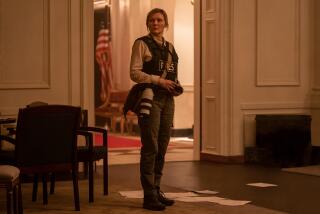The ‘Cold,’ hard truth: Black soldiers are MIA
- Share via
How do you get away with opening a Civil War tale with one of the war’s bloodiest battles in which black troops played a pivotal role but ignore them; set much of the film’s action in the slave states of Virginia and North Carolina, yet show only the briefest glimpse of black slaves laboring in the fields, and have white Southern belles mouthing antislavery platitudes? “Cold Mountain” director Anthony Minghella managed all this by tagging the word “fiction” after “historical” and deftly ducking and dodging the painful issues of slavery and race.
Minghella is hardly the first filmmaker to blink when it comes to tackling these issues. They are still America’s greatest and most enduring bugaboos. But there’s a troubling problem in his decision: Minghella elsewhere spent much time and effort trying to make the film as historically credible as possible.
He hired Civil War military consultants and spoke with historians to ensure accuracy. The Union and Confederate soldiers’ uniforms, insignias and battle flags were exact. The marching formations were precise. The Confederate trenches and fortifications were near-perfect replicas. The battlefield was meticulously re-created.
But then there’s the gut-wrenching opening battle scene. This is where the filmmakers dumped historical accuracy and reverted to fiction. It was fought in July 1864 near Petersburg, Va. The battle was characterized by monumental bungling by Union commanders. Black and white Union soldiers were slaughtered during the attack. In the ensuing carnage, the Confederate soldiers summarily executed many of the black troops even as they tried to surrender.
The bloodletting and the heroic sacrifice of the black troops were totally missing in the film. Were the filmmakers worried that the raw and brutal depiction of the racial savagery inflicted on the black troops would have shocked an audience’s senses? Or worse, that showing the barbarism would have been too racially inflammatory?
If so, they’re false fears. The countless films and documentaries on the Holocaust have not incited riots or fueled anti-Semitic violence. Historically accurate depictions of Nazi genocidal violence have broadened the public’s understanding of the danger of anti-Semitism, underscoring the need for continuing vigilance in the struggle against racism and anti-Semitism.
If “Cold Mountain” had truthfully depicted the heroism, tragedy and sacrifice of the black soldiers in the battle, it would have done much to destroy the twin myths that black soldiers played only a peripheral role in the Civil War, and that whites alone fought and died to end slavery. Nearly 200,000 blacks enlisted to fight in the Union army. The black divisions that fought in the Petersburg battle suffered the greatest number of casualties that black troops suffered in any of the Civil War battles.
The film’s blind spot to black battlefield valor is even more inexplicable considering the wide acclaim of the 1987 film “Glory.” It depicted the heroism and the struggles of an all-black Civil War regiment. In addition, a number of docudramas and PBS programs have detailed the exploits of black troops, or included them in Civil War battle scenes. There are also legions of scholarly works and articles on the pivotal role that blacks played in the Union victory.
Perhaps the most galling thing about “Cold Mountain’s” whitewash of an important historical fact is that the film could have accurately shown black troops fighting and dying without sacrificing the film’s romantic and Homeric odyssey story line. Stars Nicole Kidman, Jude Law and Renee Zellweger would still have gotten their props, critics would still have piled mountains of praise on it, and it would still have gotten its eight Golden Globe nominations.
Still, despite “Cold Mountain’s” racial fumble, the film could rekindle mild public interest in learning what really happened on the killing fields at Petersburg on that grim July day. The day after the film opened, officials at the Petersburg National Battlefield announced that they would offer walking tours of where the main fighting took place.
The tours won’t play to the crowds that will see “Cold Mountain” in theaters. But they could help tell at least some of the painful racial truths that “Cold Mountain” cold-shouldered.
More to Read
Only good movies
Get the Indie Focus newsletter, Mark Olsen's weekly guide to the world of cinema.
You may occasionally receive promotional content from the Los Angeles Times.










